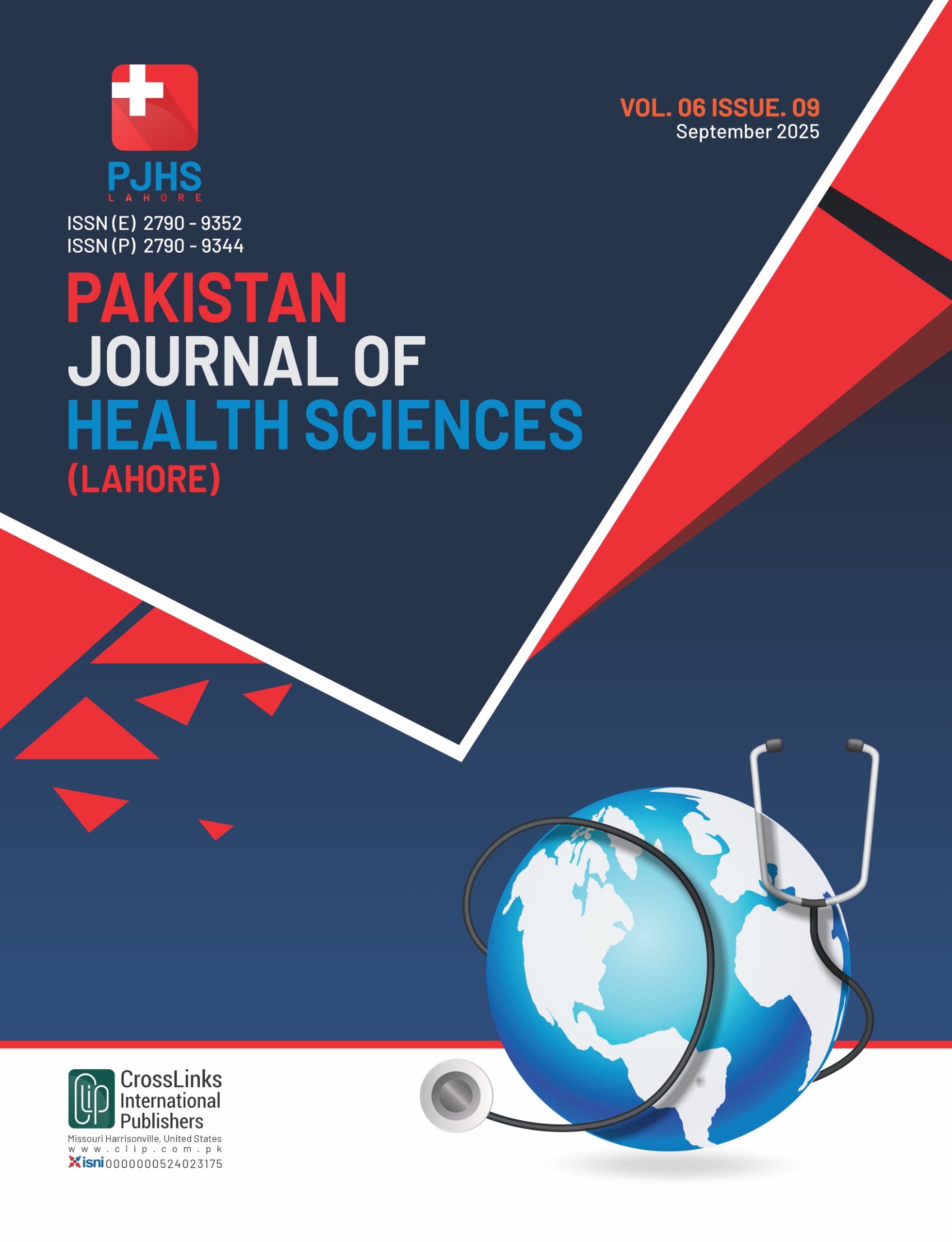Frequency of Carbapenem Resistance in the Pathogenic Gram-Negative Bacteria from Hyderabad, Sindh
Carbapenem Resistance in the Pathogenic Gram-Negative Bacteria
DOI:
https://doi.org/10.54393/pjhs.v6i9.2080Keywords:
Antibiotic Resistance, Carbapenems, Gram-Negative Bacteria, PathogensAbstract
Carbapenems are β-lactam antibiotics and are often used as a last resort to treat infections caused by the β-lactamase-producing Gram-negative bacteria owing to their ability to withstand hydrolysis by many β-lactamase enzymes. However, the emergence of carbapenem resistance in these pathogens has already been reported. In order to avoid critical situations for public health, regular monitoring and reporting of carbapenem resistance is essential. Objectives: To determine the frequency of carbapenem-resistant Gram-negative pathogens circulating in Hyderabad, Sindh. Methods: This cross-sectional study was carried out for one year. The clinical samples were collected using a convenience sampling technique from patients suspected of bacterial infections. The bacterial isolates were subjected to identification based on their microscopic, cultural, and biochemical characteristics. Sensitivity of each type of Gram-negative pathogen to antibiotics was established in terms of Clinical Laboratory Standards Institute guidelines, with the use of the Kirby-Bauer disk diffusion technique. Results: 400 clinical samples were randomly selected and they were divided into urine (n=212), pus (n=85), blood (n=68), and other (n=35). Their microbiological processing resulted in the recovery of two hundred seventy-seven isolates of Gram-negative bacteria identified as E. coli (31.05%), Enterobacter spp. (24.19%), Pseudomonas spp. (16.25%), Proteus spp. (14.44%), Klebsiella spp. (10.11%), and others (3.96%). The frequency of carbapenem-resistant isolates varied among species, with the highest prevalence in Pseudomonas spp. demonstrating 20% being carbapenem-resistant isolates. Conclusions: Carbapenem resistance in pathogenic Gram-negative bacteria has emerged. The development of carbapenem resistance in these pathogens can be catastrophic for public health.
References
Hawkey PM and Livermore DM. Carbapenem Antibiotics for Serious Infections. British Medical Journal. 2012 May; 344. doi: 10.1136/bmj.e3236. DOI: https://doi.org/10.1136/bmj.e3236
Coulthurst SJ, Barnard AM, Salmond GP. Regulation and Biosynthesis of Carbapenem Antibiotics in Bacteria. Nature Reviews Microbiology. 2005 Apr; 3(4): 295-306. doi: 10.1038/nrmicro1128. DOI: https://doi.org/10.1038/nrmicro1128
Armstrong T, Fenn SJ, Hardie KR. JMM Profile: Carbapenems: A Broad-Spectrum Antibiotic. Journal of Medical Microbiology. 2021 Dec; 70(12): 001462. doi: 10.1099/jmm.0.001462. DOI: https://doi.org/10.1099/jmm.0.001462
Codjoe FS and Donkor ES. Carbapenem Resistance: A Review. Medical Sciences. 2017 Dec; 6(1): 1. doi: 10.3390/medsci6010001. DOI: https://doi.org/10.3390/medsci6010001
Nordmann P and Poirel L. Epidemiology and Diagnostics of Carbapenem Resistance in Gram-Negative Bacteria. Clinical Infectious Diseases. 2019 Nov; 69(Supplement_7): S521-8. doi: 10.1093/cid/ciz824. DOI: https://doi.org/10.1093/cid/ciz824
Dadgostar P. Antimicrobial Resistance: Implications and Costs. Infection and Drug Resistance. 2019 Dec: 3903-10. doi: 10.2147/IDR.S234610. DOI: https://doi.org/10.2147/IDR.S234610
Tillotson GS and Zinner SH. Burden of Antimicrobial Resistance in an Era of Decreasing Susceptibility. Expert Review of Anti-Infective Therapy. 2017 Jul; 15(7): 663-76. doi: 10.1080/14787210.2017.1337508. DOI: https://doi.org/10.1080/14787210.2017.1337508
Hussain HI, Aqib AI, Seleem MN, Shabbir MA, Hao H, Iqbal Z et al. Genetic Basis of Molecular Mechanisms in Β-Lactam Resistant Gram-Negative Bacteria. Microbial Pathogenesis. 2021 Sep; 158: 105040. doi: 10.1016/j.micpath.2021.105040. DOI: https://doi.org/10.1016/j.micpath.2021.105040
Patel G and Bonomo RA. Stormy Waters Ahead: Global Emergence of Carbapenemases. Frontiers in Microbiology. 2013 Mar; 4:48. doi: 10.3389/fmicb.2013.00048. DOI: https://doi.org/10.3389/fmicb.2013.00048
World Health Organization. Prioritization of Pathogens to Guide Discovery, Research and Development of New Antibiotics for Drug-Resistant Bacterial Infections, Including Tuberculosis. 2017.
Nanjundeswaraswamy TS and Divakar S. Determination of Sample Size and Sampling Methods in Applied Research. Proceedings on Engineering Sciences. 2021 Mar; 3(1): 25-32. doi: 10.3389/fmicb.2013.00048. DOI: https://doi.org/10.24874/PES03.01.003
Bauer AW, Kirby WM, Sherris JC, Turck M. Antibiotic Susceptibility Testing by A Standardized Single Disk Method. American Journal of Clinical Pathology. 1966 Apr; 45(4_ts): 493-6. doi: 10.1093/ajcp/45.4_ts.493. DOI: https://doi.org/10.1093/ajcp/45.4_ts.493
Clinical and Laboratory Standard Institute (CLSI). Performance Standards for Anti-Microbial Susceptibility Testing. 30th Edition, M100. 2020.
Öztürk R and Murt A. Epidemiology of Urological Infections: A Global Burden. World Journal of Urology. 2020 Nov; 38(11): 2669-79. doi: 10.1007/s00345-019-03071-4. DOI: https://doi.org/10.1007/s00345-019-03071-4
Urooj S, Bano S, Tunio SA, Memon BA, Abbasi SM, Rajput Z. High Frequency of Gram-negative Bacilli (GNB) Pathogens in Wounds and Other Clinical Specimens: A Grave Public Health Concern. BioScientific Review. 2024 May; 6(2): 20-30. doi: 10.32350/bsr.62.2. DOI: https://doi.org/10.32350/bsr.62.2
Abassi SM, Bano S, Tunio SA, Memon BA, Korejo IA. Frequency of Extended Spectrum Β Lactamases Producers in Gram-Negative Bacilli Pathogens. Rawal Medical Journal. 2024 Apr; 49(2): 255-.
Niranjan V and Malini A. Antimicrobial Resistance Pattern in Escherichia Coli Causing Urinary Tract Infection among Inpatients. Indian Journal of Medical Research. 2014 Jun; 139(6): 945-8.
Abro UA, Bano S, Tunio SA, Abassi SM. Antibiotic Resistance Trends in High-Risk Lineages of Salmonella Enterica Serovar Typhi: A Study Spanning Pre to Post COVID-19 Pandemic. Infection, Genetics and Evolution. 2024 Sep; 123: 105632. doi: 10.1016/j.meegid.2024.105632. DOI: https://doi.org/10.1016/j.meegid.2024.105632
Detho H, Bano S, Tunio SA, Abbasi SM, Ahmed M. Biofilm Formation and Antibiotic Resistance in Uropathogenic Escherichia Coli: The Quest for Effective Treatment of Urinary Tract Infections. Pure and Applied Biology. 2023 Nov; 13(1): 38-46. doi: 10.19045/bspab.2024.130004. DOI: https://doi.org/10.19045/bspab.2024.130004
Hauck C, Cober E, Richter SS, Perez F, Salata RA, Kalayjian RC et al. Spectrum of Excess Mortality Due to Carbapenem-Resistant Klebsiella Pneumoniae Infections. Clinical Microbiology and Infection. 2016 Jun; 22(6): 513-9. doi: 10.1016/j.cmi.2016.01.023. DOI: https://doi.org/10.1016/j.cmi.2016.01.023
Downloads
Published
How to Cite
Issue
Section
License
Copyright (c) 2025 Pakistan Journal of Health Sciences

This work is licensed under a Creative Commons Attribution 4.0 International License.
This is an open-access journal and all the published articles / items are distributed under the terms of the Creative Commons Attribution License, which permits unrestricted use, distribution, and reproduction in any medium, provided the original author and source are credited. For comments













